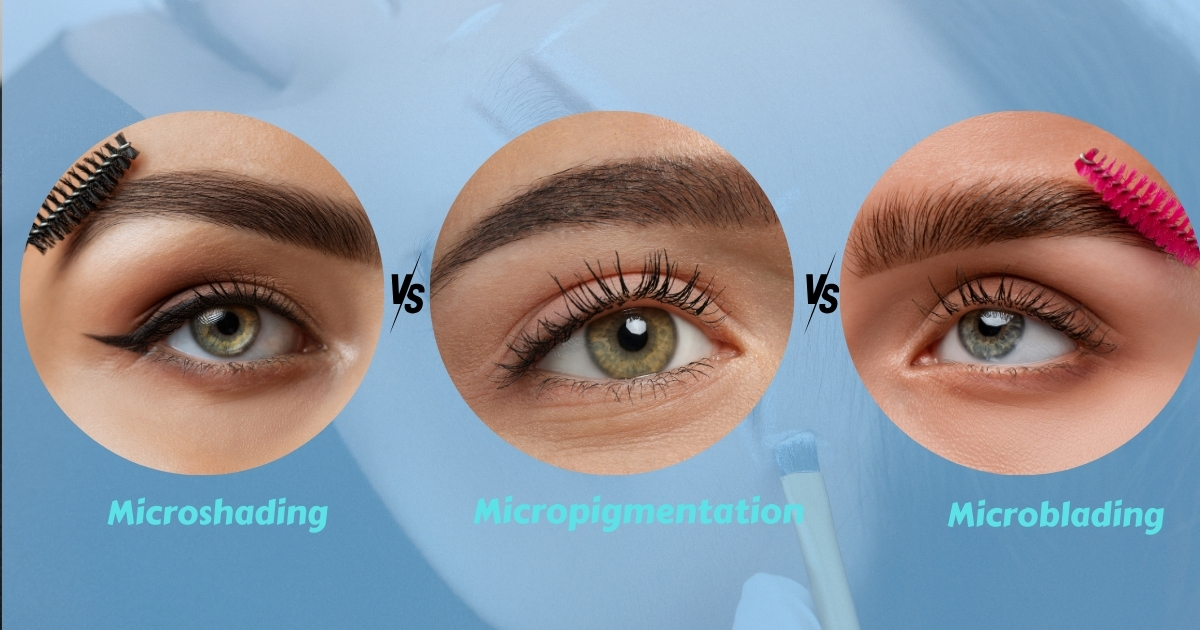Eyebrow Microshading vs Micropigmentation vs Microblading: Understanding the Differences
By Milla Rosen, Dec 13, 2024

When it comes to enhancing the natural beauty of your eyebrows, there are several techniques available, including eyebrow microshading, micropigmentation, and microblading. While they all aim to give you fuller, well-shaped brows, the methods and results can vary significantly. Understanding the differences between these three eyebrow treatments is key to choosing the one that’s right for you.
What is Microblading?
Microblading is one of the most popular eyebrow treatments in recent years, known for its ability to create the appearance of natural, hair-like strokes. The process involves a manual tool with tiny needles that deposit semi-permanent pigment into the skin’s superficial layers. Notably, microblading is only suitable for dry skin, not oily skin type. Moreover, microblading causes scarring (potentially unrepairable skin damage) and hair loss.
Key Features of Microblading:
- Appearance: Microblading mimics natural hair growth with fine, crisp strokes, making it ideal for those with sparse or thin eyebrows.
- Pigment Type: Uses a semi-permanent pigment that fades over time, typically lasting between 1 to 3 years.
- Best For: Those looking for a natural, defined look with a focus on creating individual hair strokes.
What Is Traditional Hair Restoration for Beards?
Traditional hair restoration, such as follicular unit extraction (FUE) or follicular unit transplantation (FUT), involves surgically transplanting hair follicles from other parts of the body (typically the scalp) to the beard area. This method focuses on growing natural hair in previously sparse or patchy areas.
Key Features of Hair Restoration:
- Surgical procedure requiring downtime
- Results depend on hair growth cycles
- Typically permanent once the hair follicles establish
- Requires a suitable donor area with sufficient hair
Pros:
- Natural, realistic results
- Ideal for those with sparse or over-plucked eyebrows
- Minimal downtime
Cons:
- Requires regular touch-ups as the pigment fades
- Skin incisions could lead to tissue damage
- Not as long-lasting as other methods
What is Micropigmentation?
Micropigmentation, also known as permanent makeup, is a technique that uses a machine to insert pigment into the skin. This process is more similar to tattooing, where the pigment is applied deeper into the skin compared to microblading.
Key Features of Micropigmentation:
- Appearance: Micropigmentation typically offers a bolder look compared to microblading, often used for a more defined or filled-in eyebrow shape.
- Pigment Type: Permanent pigment is used, meaning the results last longer than microblading — often between 3 to 5 years.
- Best For: Those who prefer a stronger, more defined brow or need to fill in areas with little to no hair.
Pros:
- Longer-lasting results (3-5 years)
- Works well for all skin types, including oily skin
- Offers a more solid, defined brow shape
- May encourage collagen production, which encourages real hair growth
Cons:
- Touch-ups are still needed overtime to maintain color and shape
- Deeper pigment application can make it harder to change brow shapes in the future
What is Microshading?
Microshading, often referred to as "powder brows," combines the techniques of both microblading and micropigmentation. The method involves using a machine to deposit small dots of pigment into the skin, creating a soft, shaded effect that resembles the look of powder-filled eyebrows.
Key Features of Microshading:
- Appearance: Microshading creates a soft, powdered look, often providing a fuller and more defined appearance compared to microblading. The result is less harsh and more blended.
- Pigment Type: Similar to micropigmentation, microshading uses semi-permanent or permanent pigment, with results lasting anywhere from 1 to 3 years.
- Best For: Those who want a softer, more defined brow without the sharp lines created by microblading.
Pros:
- Softer, fuller look without harsh lines
- Works well for all skin types, especially oily or sensitive skin
- Lasts longer than microblading
Cons:
- Not as natural-looking as microblading
- May not work well for people with very thin or sparse brows (compared to microblading)
- May not work well for people with very thin or sparse brows (compared to microblading)
Which is Right for You?
Choosing the best eyebrow treatment depends on your goals, skin type, and personal preferences. Here’s a simple guide to help you decide:
Conclusion
Each of these eyebrow techniques—microblading, micropigmentation, and microshading—offers distinct advantages depending on your desired outcome. Microblading provides the most natural look with fine hair strokes, while micropigmentation is ideal for those looking for bold, long-lasting results. Microshading, on the other hand, offers a softer, powdered effect that suits a variety of skin types.
By understanding the differences, you can choose the technique that best suits your needs and gives you the eyebrow look you’ve always dreamed of. If you're unsure, it’s always a good idea to consult with a professional who can guide you based on your eyebrow shape, skin type, and aesthetic preferences.
Hours of Operation:
Our Prices
- Permanent Eyebrows $599.00
By Milla Rosen
(Touch up only $199)* - Permanent Eyebrows $400.00
By other artists
(the price includes 2 sessions,
the full amount to be paid at first appointment) - Permanent Eyebrows Correction $1000.00
By Milla Rosen
(consists of 2 sessions, $500 per session)
+ $100 for every additional session if needed. - Permanent Eyeliner $599.00
By Milla Rosen
(Touch up only $199)* - Top Eyeliner only $499.00
By Milla Rosen
(Touch up only $199)* - Bottom Eyeliner only $499.00
By Milla Rosen
(Touch up only $150)* - Permanent Lips $599.00
By Milla Rosen
(Touch up only $199)* - Color refreshment touch up procedure $400.00
By Milla Rosen
($250 for second session, if needed)* - Consultation
A $50.00 refundable fee is required
in order to reserve your consultation appointment. - * Touch up session within first 3 month after initial session.
Forms of Payment
We accept all major credit cards. We DO NOT accept American Express or personal checks.
